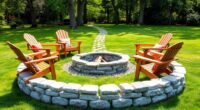To build a raised garden bed, first choose a sunny, well-drained location and clear away grass, weeds, and debris. Construct a sturdy frame using durable materials like cedar or composite, ensuring it’s level and secure. Dig a shallow trench for stability and fill the frame with nutrient-rich soil mixed with compost and topsoil. Add mulch on top to retain moisture. With proper planning and execution, you’ll set the stage for a thriving garden—keep exploring for detailed steps.
Key Takeaways
- Choose a suitable location with ample sunlight, proper drainage, and protection from strong winds.
- Construct a sturdy frame using durable materials like cedar or composite wood, ensuring it is level and secure.
- Prepare the site by removing grass, weeds, and debris, then loosen existing soil to improve root growth and drainage.
- Fill the bed with a nutrient-rich soil mix, pressing gently to eliminate air pockets and ensure proper compaction.
- Add mulch on top to retain moisture, suppress weeds, and complete the setup for planting.

Building a raised garden bed is a practical way to improve your gardening space, especially if your soil is poor or drainage is an issue. When you decide to build one, start with soil preparation. You want to guarantee your plants have the best environment to thrive, so focus on creating a healthy, nutrient-rich soil mix. Remove any grass, weeds, or debris from the designated area. Loosen the existing soil to facilitate better root growth and drainage. Once cleared, fill your bed with a combination of compost, topsoil, and organic matter. This mixture provides essential nutrients and improves water retention, which is vital for healthy plants. Avoid using subpar soil or just dirt from your yard, as it may be compacted or lacking proper nutrients. Instead, aim for a balanced blend that promotes aeration and moisture retention.
As you plan your garden design, think about how your raised bed fits into your overall landscape. Decide on the size and shape that best suits your available space and gardening goals. A common size is 4 feet by 8 feet, which allows easy access from all sides. Consider placing your bed in a location that receives ample sunlight, ideally at least six hours a day, and is protected from strong winds. You’ll want to make certain your garden design includes proper drainage; a slight elevation or a bed constructed with well-ventilated materials will help prevent waterlogging. Think about accessibility too—if you’re planting vegetables or herbs, you’ll want to minimize bending and reaching, so adjust the height accordingly.
Once you have your soil prepared and your garden design mapped out, you can start building the frame. Use sturdy materials like cedar, composite, or pressure-treated wood for longevity. Construct the sides to your chosen dimensions, making sure they’re level and secure. When installing the frame, it’s a good idea to dig a shallow trench for the base to help stabilize it. After the frame is in place, fill it with your prepared soil mixture, pressing down gently to remove air pockets. Adding mulch on top of the soil can help retain moisture and suppress weeds. By paying attention to soil preparation and thoughtful garden design, you set the foundation for a thriving, productive raised garden bed that will enhance your gardening experience.
Frequently Asked Questions
What Are the Best Materials for a Raised Garden Bed?
When choosing materials for your raised garden bed, consider material durability to guarantee it lasts through seasons. You want options that resist rot and pests, like cedar or composite lumber. Cost-effective options include recycled plastic or repurposed wood, which can save money while being eco-friendly. By selecting durable, affordable materials, you create a sturdy, long-lasting garden bed that fits your budget and gardening needs.
How Deep Should a Raised Garden Bed Be?
When considering how deep your raised garden bed should be, think about soil depth and plant root space. Generally, aim for at least 12 inches deep to provide enough room for roots to grow healthily. If you’re planting deep-rooted vegetables, go even deeper, around 18-24 inches. This guarantees your plants have ample soil to access nutrients and water, promoting strong growth and a bountiful harvest.
Can I Build a Raised Bed on Concrete?
You can build a raised bed on concrete, but you need to take into account raised bed placement and concrete compatibility. Use a sturdy frame like wood or composite that won’t rot or crack on concrete surfaces. Elevate the bed slightly with bricks or pavers to improve drainage and prevent direct contact with the concrete. This setup ensures healthy soil and plants while providing stability and durability for your raised garden bed.
How Do I Prevent Pests in My Raised Garden Bed?
Think of your garden as a fortress, and pests as invaders trying to breach your defenses. To keep them at bay, you can use companion planting, pairing plants that naturally repel pests, and apply organic pesticides that are safe for your plants and the environment. Regularly inspecting your bed and removing pests by hand also helps. These strategies work together like a well-trained army to protect your thriving garden.
What Is the Ideal Soil Mix for Raised Beds?
You should aim for an ideal soil mix that promotes healthy plant growth. Start with quality compost and organic matter, then add soil amendments like peat moss or aged manure for nutrients. To guarantee good drainage, mix in coarse sand or perlite. This combination improves drainage and provides essential nutrients, creating a balanced environment that encourages root development and overall plant health in your raised garden bed.
Conclusion
Building a raised garden bed is a rewarding project that can boost your gardening success. Did you know that raised beds can improve soil drainage and aeration by up to 50%, leading to healthier plants? By following these simple steps, you’ll create a durable, efficient space for your plants to thrive. With just a little effort, you’ll enjoy fresh produce and a beautiful garden in no time. Happy gardening!









